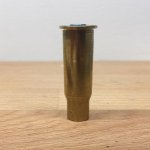I’ve got a Winchester 1894 in 30-30 that was manufactured in 1895 and rebarreled at some point, the date stamp on the barrel is 1946.
I finally got around to shooting it for the first time a couple days ago. After firing 4 rounds I picked up a case to inspect it and found the primers were pushed halfway out of the pocket. I was shooting federal 170 gr factory ammunition.
What could cause this? Fwiw, I measured the shoulder of the fired case and compared it to the shoulder of a loaded round and found the shoulder has moved forward .024” on the fires cases. As the 30-30 headspaces on the rim, this couldn’t be the issue, right?
I finally got around to shooting it for the first time a couple days ago. After firing 4 rounds I picked up a case to inspect it and found the primers were pushed halfway out of the pocket. I was shooting federal 170 gr factory ammunition.
What could cause this? Fwiw, I measured the shoulder of the fired case and compared it to the shoulder of a loaded round and found the shoulder has moved forward .024” on the fires cases. As the 30-30 headspaces on the rim, this couldn’t be the issue, right?















































































